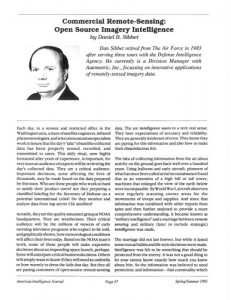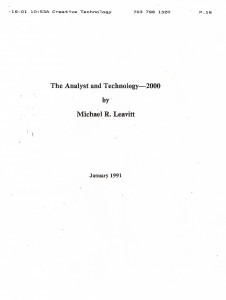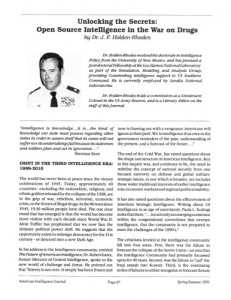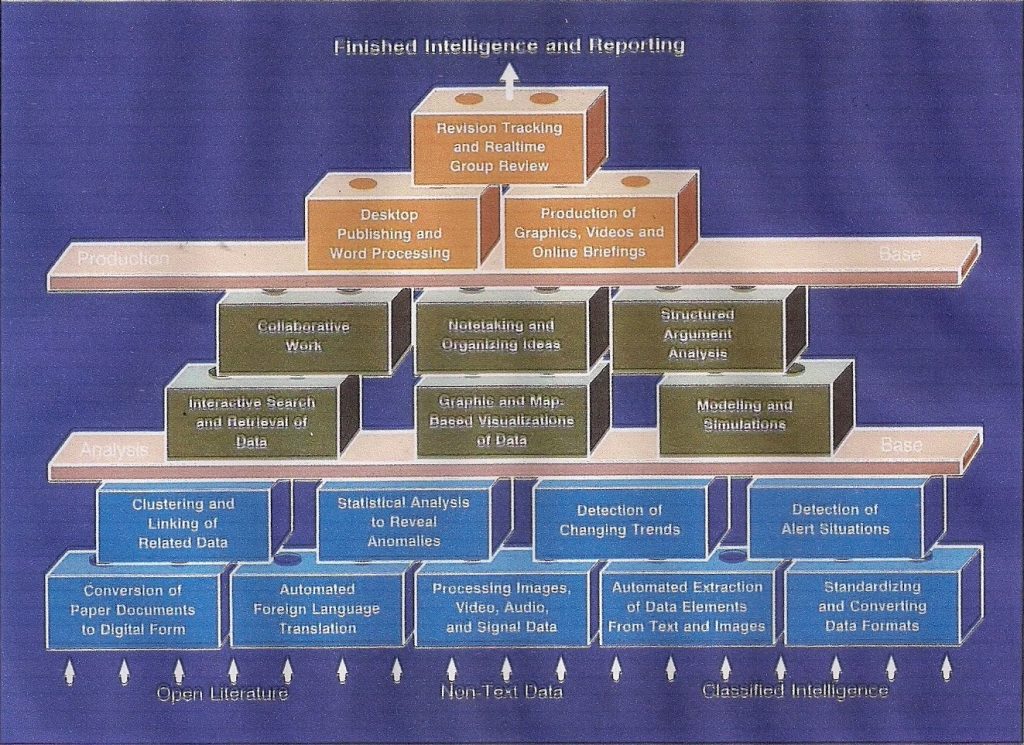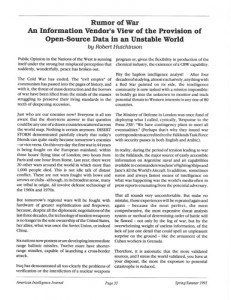
1992 Sibbit (US) Commercial Remote Sensing–Open Source Imagery Intelligence
Historic ContributionsReference: The Analyst and Technology–2000 Essay (1991)
Director of National Intelligence et al (IC), Historic Contributions1992 Holden-Rhodes (US) Unlocking the Secrets–Open Source Intelligence and the War on Drugs
Historic Contributions1989 Webb (US) CATALYST: Computer-Aided Tools for the Analysis of Science & Technology
Analysis, C4/JOE/Software, Historic Contributions, Technologies, ToolsReference: Mapping Hypertext (1989)
Analysis, Analysis, Augmented Reality, C4/JOE/Software, Collective Intelligence, Geospatial, Historic Contributions, info-graphics/data-visualization, InfoOps (IO), IO Mapping, Journalism/Free-Press/Censorship, Maps, Methods & Process, Monographs, Open Government, Policy, Reform, Research resources, Strategy, Tools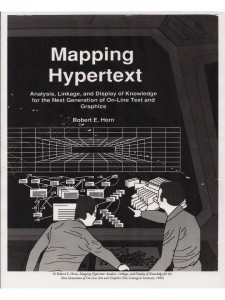
This is the seminal work in what the author has long named “information mapping.” Posted as a public service with permission of the author, under Creative Commons license. No commercial exploitation is permitted without documented consent of the author.
Book intended to be read two pages at a time. The author suggests printing by the chapter, and then reading with even pages to the left and odd pages to the right, two pages at a time.
Visit the author's HOME PAGE.
1989 General Al Gray with Robert Steele on Global Intelligence Challenges
About the Idea, Historic Contributions, Insurgency & Revolution, Intelligence (Government/Secret)
General Gray was known as a warrior, but he was also an intelligence professional and uniquely among all the flag officers I have ever known, an inspiring educator. He created not just the Marine Corps Intelligence Center, but the Marine Corps University, new forms of informal research to empower younger officers and explore the “edges” beyond the conventional comfort zone. He was, in brief, a warrior-scholar who epitomizes all lthat should be good in our leaders.
Global Intelligence Challenges in the 1990’s
by General Alfred M. Gray, Commandant of the Marine Corps
Ghost-written by Robert David Steele, edited by John Guenther (RIP)
“The Corps must be ‘fighting smart' if it is to meet the combined challenge of an austere fiscal environment and an increasingly lethal expeditionary environment.”
A. M. Gray, CMC
As the Joint Chiefs of Staff observe the dramatic changes taking place in Eastern Europe and the Soviet Union on the one hand, and the increasingly volatile and lethal Third World on the other, it is immediately apparent that the 1990's will be a period of global and sweeping challenge to both intelligence professionals and the policy-makers and tactical commanders they support. When we add to this equation the severely constrained fiscal environment, forcing all of us to do more and more with less and less, these challenges verge on being overwhelming.
Our ability to gauge events and their implications in Eastern Europe; our ability to estimate and forecast Third World change in all dimensions (socio-economic and ideo-cultural as well as the more traditional political-military); our ability to develop indications and warnings of emerging threats in the Third World; our ability to provide intelligence for counter-narcotics and counter-terrorist programs; and our ability to protect national security secrets through both offensive and defensive counterintelligence; these will define and guide the national strategy, national defense posture, and national military force structure and systems acquisition in the 1990's.
The Chairman of the Joint Chiefs of Staff and the Service Chiefs will require the absolute best intelligence available if they are to make prudent decisions about fiscal, system, and operational matters. To the extent that intelligence fails or proves inadequate, our national defense programs suffer, both through the expenditure of millions of dollars on inappropriate capabilities, and through a lack of readiness to deal with unanticipated or underestimated threats. We need to strike a better balance between our capabilities and actual requirements. We simply cannot afford to equip and train for the wrong war.
The U.S. Marine Corps, as the nation's “force of choice” for expeditionary operations, must be extremely concerned and vocal about global intelligence challenges in the 1990's. The Marine Corps is also a microcosm of the Department of Defense as a whole. A Marine Air Ground Task Force (MAGTF) is self-contained and supported, must be able to work with all other Services and civilian agencies overseas, in all operational plans worldwide, and must have constant near-real-time access to national, theater, and in-country intelligence. Our Corps is particularly well-suited to respond to these challenges, but to be most effective, we must obtain more balanced intelligence coverage of the Third World.
Since WWII there have been over 200 situations requiring the use of U.S. forces; roughly 85% required employment of the Marines, and virtually all were in the Third World. Prior to WWII and the establishment of a bipolar world, there is an even richer history of Marine Corps employment in expeditionary and constabulary operations throughout the Third World.
As nuclear/conventional threats stabilize, a multipolar world is forming, characterized by shared global concerns as well as competing interest in regions containing powerful Third World nations. This environment offers both opportunity and challenge for policy-makers concerned with the protection of U.S. interests.
The east-west factor will not be the central focus of our contingency planning in the 1990's. This represents a fundamental challenge to the intelligence community, because the emerging threats in the Third World require a distinctly different approach to intelligence than does the relatively static threat posed by the nuclear and conventional forces of the Soviet Union and its allies.
In recognition of this challenge, we are doing what we can to improve tailored intelligence for Marine Corps' need at both the strategic and tactical levels.
— At Headquarter Marine Corps, we have combined our Intelligence Division and C4 Divisions to form the Command, Control, Communications, Computer, Intelligence and Interoperability (C412) Department under a Major General, Assistant Chief of Staff. This department will ensure execution of my C412 plans and policies which are best exemplified by recent guidance to Marine Corps general officers: “If you can't manage information and data, you can't command.”
— At Quantico, we are creating and bringing up to speed a service-level intelligence center within the Marine Corps Combat Development Command. I have tasked that activity with becoming, as quickly as possible, a model all-source fusion center. With assistance from the General Defense Intelligence Program, we expect this modest initiative to become a lead site for “state of the shelf” intelligence analysis tools,[iii] and serve as a catalyst for combat development activities involving force structuring, doctrine, equipment requirements, and the training and education of our warriors. The Intelligence Center will also serve as a gateway to the various reservoirs of both classified and open source knowledge about the world wherein our MAGTF's are most likely to be employed.
— In the Fleet Marine forces we have formed the Surveillance, Reconnaissance, and Intelligence Groups (SRIG). This internal initiative brings together under one commander the resources necessary to meet the operational and tactical commander's needs, and significantly facilitates the integration of command & control, communication, computing, and intelligence resources at the tactical level.
Our understanding of the difference between the conventional and the emerging threat is illustrated below:
| Conventional Threat
– Governmental |
Emerging Threat
– Non-Governmental |
Figure 1: Conventional versus Emerging Threat
This radical difference between conventional threats and emerging threats poses a strategic challenge that must be met with a strategic response. A fundamental element of our success in developing a strategic response will be our ability to agree on a broader continuum of civilian and military programs requiring in-depth sustained intelligence support. In dealing with “low intensity conflict” it is imperative that the importance of intelligence to all activities, including overt civilian and military programs, be validated, and resources applied accordingly.
Our information programs cannot succeed if intelligence does not help us understand the important cultural perspectives and the reactions of foreign groups to our themes and actions.
In brief, we believe that the very powerful repetitive technical collection capabilities we have developed against the more conventional military and industrial targets in ‘denied areas” will no longer suffice as the centerpiece of our national intelligence structure.
We must develop reliable capabilities which afford us both warning and – perhaps more importantly – understanding of emerging threats such as are predominant in the increasingly lethal and volatile Third World. I am greatly encouraged by the increasing emphasis within the U.S. intelligence community on establishing a long-term foundation for analysis of all important aspects of the Third World as well as indications and warnings of low-intensity conflict.
Implicit in this changing threat is the requirement to train and educate all of our Marines, especially our intelligence specialists, to respond to these non-traditional challenges. Intelligence professionals must also take the lead in developing useful intelligence products that help orient the intelligence consumer to the need for more and better Third world intelligence so that intelligence priorities and corresponding resource allocations are appropriately balanced.
In this era of fiscal austerity, we must apply the business concept of ‘return on investment” to our decision-making regarding intelligence in support of national security. This will help us develop a better balance between collection and processing, between emphasis on nuclear/conventional versus emerging threats, and between satisfaction of national and tactical (Country Team) requirements.
What does this mean from the Marine Corps' point of view?
First, as noted above, it means we must recognize the needs of civilian agencies and military theater commanders coping with “low-intensity conflict” (or, my preferred term, revolutionary warfare). If threat is a factor in determining national investments in security assistance and foreign aid, then a more aggressive program of Third World intelligence analysis and forecasting is needed if we are to justify long overdue and underfunded peaceful preventive measures in this vital area of concern and potential.
It means we must do much more in funding clandestine HUMINT able to meet our needs for in-depth understanding of Third World intentions and non-conventional threats (e.g. bio-chemical terrorism).
It means we must apply technology in ways responsive to our most immediate and frequent threats, and must balance our use of technology with the intelligence cycle:
- Capabilities must be integrated both vertically and horizontally – Inter-agency policies and practices must be developed which permit the fusion of Information at every hierarchical level, beginning with the Country Team. At the same time, we should develop means of avoiding redundant processing of the same information by every agency and service;
- Information technology must be managed and exploited as an intelligence multiplier, dramatically improving the processing of collected intelligence as well as the exploitation of untapped open sources.
Externally, much more could be done to leverage information technology, especially against existing open sources of information such as Third World print and voice media. Our Intelligence Center at Quantico has worked closely with others in the intelligence community to understand where we can do better in this area. Several initiatives the Marine Corps would support but cannot unilaterally fund include:
- Establishment of a separate Open Source Committee co-equal to other national-level disciplinary committees; this is essential if community programs to apply information technology to open source exploitation are to be cost-effective and mutually reinforcing;
- Global program of selected digitization of newspapers and journals with initial emphasis on third World countries with narcotics and terrorist targets;
- Establishment of a central repository of government owned open source data bases such as developed by the Foreign Broadcast Information Service (FBIS) and the Joint Publications Research Service (JPRS);
- National program to digitize selected biographic and other hard-copy records pertaining to the Third World;
- Expansion of the Defense Gateway Information System (DGIS) to include management of the latter three initiatives; and
- Coordinated community-wide development of generic functional requirements and a common software/system solution for an intelligence analysts' workstation with a single user interface and access to multiple remote databases at all security levels.
We must begin the difficult task of developing a comprehensive database and advanced language and area specialist cadres for all Third World countries. The Marine Corps is prepared to take the lead in this area. We see the Defense Advanced Language and Area Studies Program as a primary means to develop Third World expertise.
We must devote the same energy, and much more creativity, to the challenge of understanding indications and warning for revolutionary warfare. I include in such warfare terrorism as it might manifest itself through domestic economic sabotage and information technology “viruses”, as well as the narcotics threat.
In keeping with our commitment to the fight against illegal drugs, and the ease with which threat targets move back and forth over “the water's edge”, we must provide strong support to law enforcement agencies as they seek to develop their “strategic” intelligence capabilities and related secure communications and methods of operations. This is a two-way street. National agencies must develop legal, automated means of receiving and exploiting raw information collected by law enforcement officials overseas.
The complexity of the operational environment in the Third World is illustrated by the specific Marine Air Ground Task Force (MAGTF) missions listed below, all part of “low intensity conflict”:
Stability Operations (Civil-Military Operations)
Presence/Amphibious Ops
Humanitarian Assistance
– Deliberate Ops
– Disaster Relief
– Civic Action
Mobile Training Teams
Internal Security Support
Peacekeeping Ops
Counternarcotics Ops
Counterinsurgency Ops
Limited Objective Operations (Short of General War)
Peacetime Contingencies
– Non-combatant Evacuation
– Amphibious Raid
– Seizure of Advanced Bases
Counterterrorism Ops
Figure 2: Low-Intensity Conflict Missions
The increasing sophistication of Third World opponents such as are represented by narco-revolutionaries and terrorists, presents us with particularly difficult challenges.
Let me illustrate one specific challenge – the SIGINT threat. Using “state of the art” commercially available equipment, they frequently outpace or avoid entirely the capabilities developed by the government through its lengthy procurement process. Below are several of the military and commercial technologies which would confront the Marine Corps in various contingency scenarios:
– Low Probability of Intercept/Low Probability of Detection (LPI/LPD) signals
– Frequency agile radios
– Direct sequence spread spectrum radios
– Burst communication
– Citizen-band and Marine-band radios
– Use of higher frequencies (communications & radars)
– Use of telephones (especially cellular telephone), land lines, and packet radio systems for voice & data
– Secure voice systems and other encryption devices
– Extremely wide variety and complexity of potential targets, creating a “needle in the haystack” problem
Figure 3: SIGINT Characteristics of Selected Third World Threats
Be assured, our SIGINT/EW planners are addressing this problem in close coordination with national and law enforcement agencies. Still, the complexity of the problem is obvious.
In closing, I would make three key points:
Revolutionary warfare is just that – revolutionary. It does not respond to negotiation or reason as we understand the terms. When revolutionaries “negotiate” they do so to buy time and improve their position. Intelligence in the 1990's must be able to document revolutionary deception in terms stark enough to support the employment of force where appropriate;
“Low intensity conflict” Is neither “low,” “limited” nor necessarily “conflict.” It covers everything from nation-building to a Marine Corps specialty, “creating the maximum amount of violence in the smallest possible space.” Intelligence in the 1990's must support the full spectrum of responses including overt civilian and military programs overseas, as well as law enforcement agencies at home. Intelligence must be able to tell us, down to individual personalities and neighborhoods, “who,” “where,” and “how much” of “what” is needed, and whether what has been applied has been effective. If it doesn't know, it must have assets able to obtain and report the information within six hours of demand.
Crises and expeditionary operations in the Third World are by their nature “come as you are” affairs. We will not have the time to “surge” our intelligence (including mapping, charting, and geodesy). Nor will we have the time to train, equip, and organize our forces for radically new threats which have not been forecast. We must do our homework today in order to be truly prepared – mentally, physically, and emotionally.
Only an investment in people – advanced language and area specialists able to help us understand the Third World – will lead to the appropriate and cost-effective development of expeditionary forces trained, equipped, and organized for dealing with the emerging threats and opportunities in the Third World.
Your Marine Corps will be the first to fight; I give you my assurance we are also going to be fighting smart.”
As subsequently published:
Al Gray (Ghost-Written by Robert Steele), “Global Intelligence Challenges in the 1990’s,” American Intelligence Journal, Winter 1989-1990, pp. 37-41.
PDF (6 Pages): 1989 Global Intelligence Challenges in the 1990's

